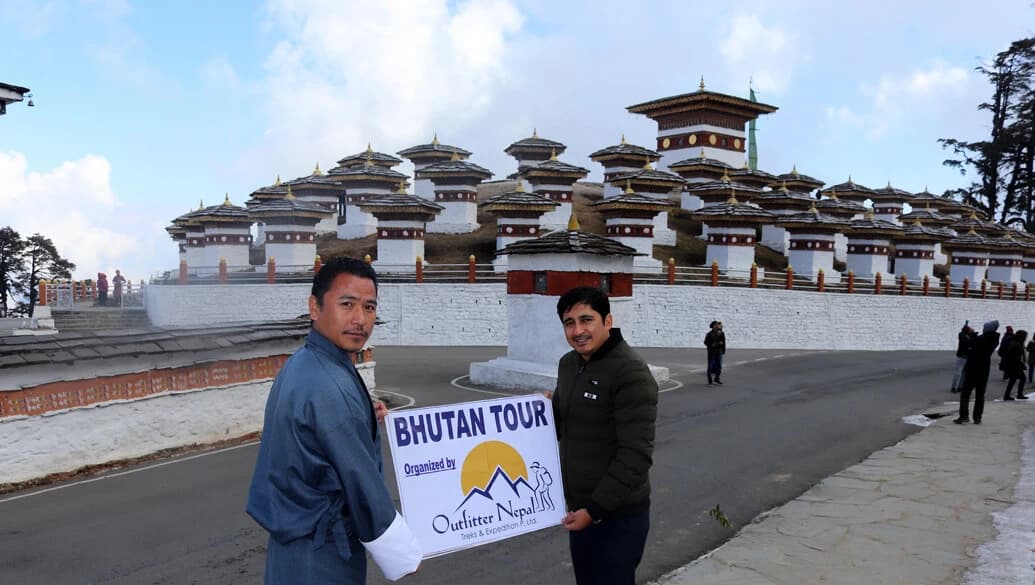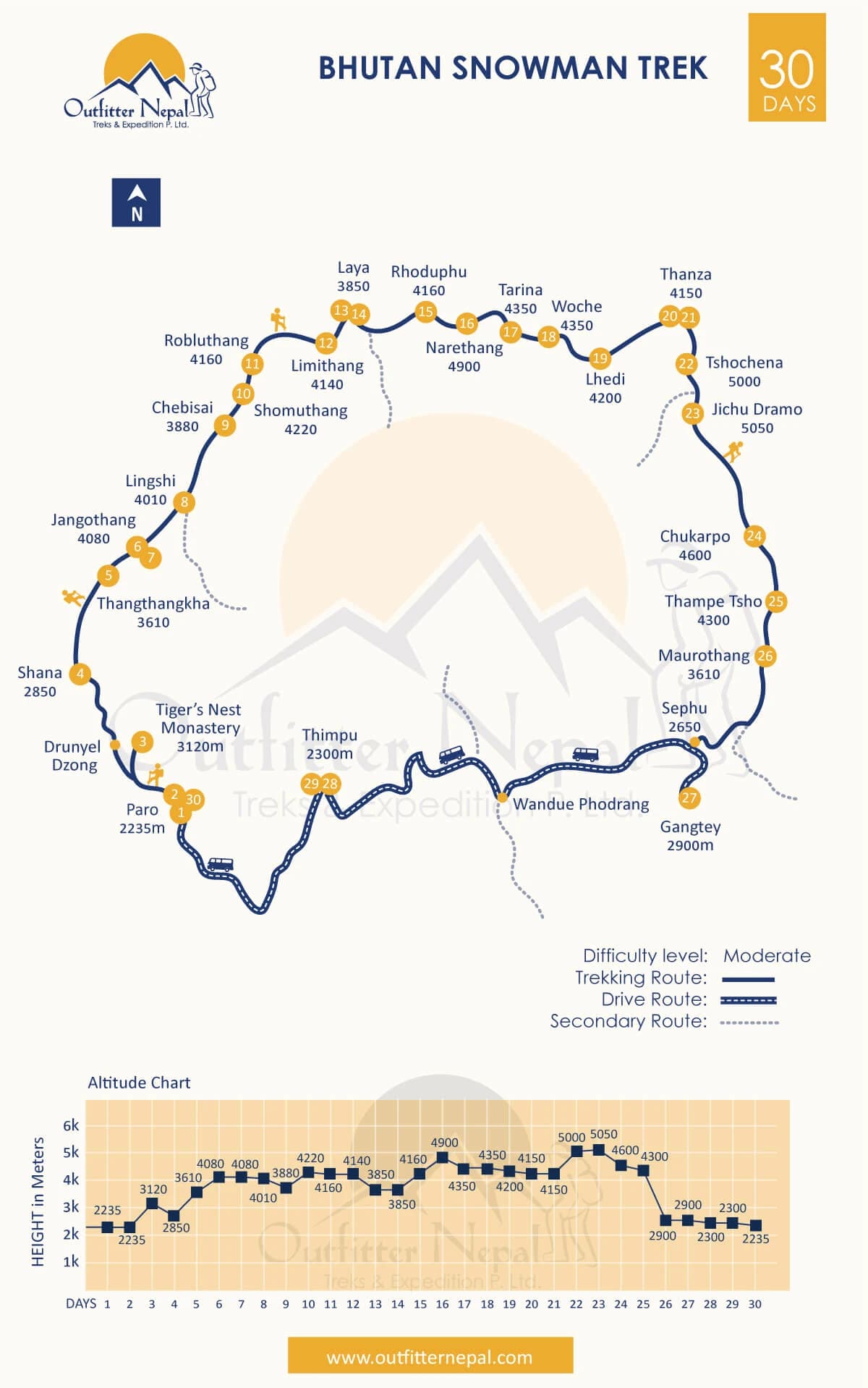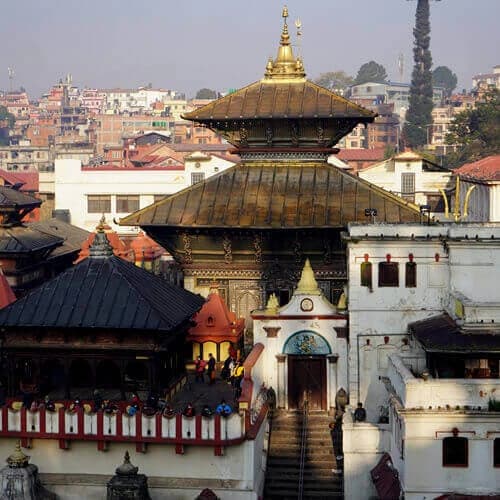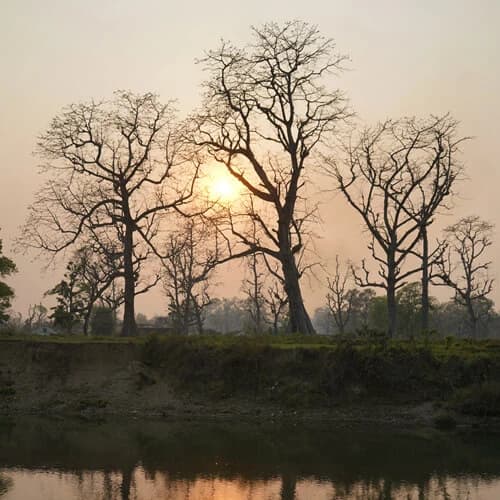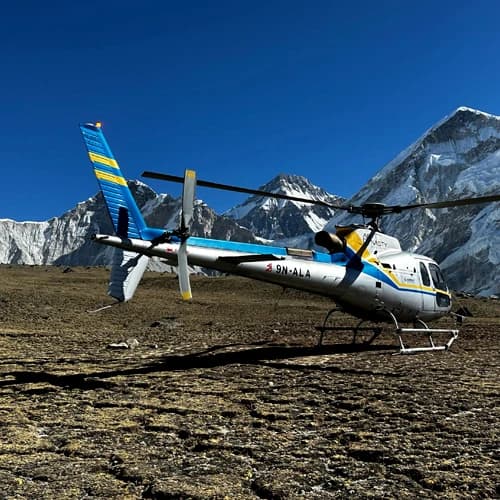Bhutan Snowman Trek Trip highlights
- Magnificent view of peaks like Jomolhari and Gangkar Puensum.
- Cross through 11 thrilling and challenging passes over 16,000 ft (4,876m).
- Experience authentic Bhutanese culture in remote settlements.
- Trek through serene forests, pristine meadows, and beautiful valleys.
- Spot rare wildlife like blue sheep, takin, and even the elusive snow leopards.
Why is it called Snowman Trek?
The Snowman Trek Bhutan is named for the challenging and often snow-covered mountain passes that trekkers must navigate along the route. The term "Snowman" also reflects the extreme conditions of the trek, with its high-altitude passes and cold temperatures, making it feel like an adventure in a "winter wonderland." The name captures both the harshness and beauty of the trek and the resilience required to complete it. The 30-day itinerary takes you through Bhutan's remote and rugged Himalayan landscape, snow terrains, and high-altitude regions.
The trek also offers views of towering peaks like Jomolhari and Gangkar Puensum, the highest unclimbed mountain in the world. The route traverses rugged terrain, dense forests, alpine meadows, and high-altitude valleys and crosses 11 passes above 4,500 meters (14,764 feet). During this remarkable journey, trekkers also experience traditional Bhutanese culture in local villages, where they can observe local lifestyles and Buddhist practices. For an enjoyable trek experience, you must have a high fitness level and determination to deal with adversities. The 30 days Snowman trek Bhutan is a true adventure for trekkers seeking a life-changing journey through one of the world's last untouched wildernesses.
Why Choose the Snowman Trek?
The Snowman Trek is an exceptional choice for adventurers seeking a genuinely challenging and immersive experience. Its unparalleled natural beauty offers breathtaking views of the world's highest peaks while navigating rugged terrain and crossing high-altitude passes. Apart from the natural wonders, it provides a rare opportunity to immerse yourself in Bhutan's rich culture and spiritual heritage. The trek's remote location ensures a sense of solitude, allowing you to connect deeply with nature and escape the crowds on other popular treks. The Snowman Trek Bhutan is an unforgettable adventure for those seeking a test of endurance combined with cultural discovery and unmatched wilderness
How challenging is the Snowman trek?
Snowman Trek is one of the world's most challenging and physically demanding treks. The route spans about 215 miles and takes you through remote, high-altitude areas in Bhutan. Travelers must hike through steep ascents and descents for several above 4,000 meters (13,000 feet). Some of the factors that make the Snowman trek Bhutan demanding include.
- Altitude: The trek reaches over 5,000 meters, requiring careful acclimatization to prevent altitude sickness and ensure safe trekking.
- Length: The long trek route demands endurance and physical preparation for daily hikes.
- Weather: The weather can be unpredictable, with cold temperatures, rain, and snow requiring trekkers to be prepared throughout the journey.
- Technical Difficulty: The trail involves steep ascents and rocky paths, making it physically demanding and requiring muscular endurance.
- Remote Areas: The trek passes through isolated, remote areas with limited access to medical facilities, making it crucial to be self-sufficient and prepared for emergencies.
Who is this trek for?
The Snowman Trekking is ideal for seasoned trekkers who are physically fit, experienced in high-altitude hiking and comfortable with extended trips in remote, rugged areas. Assessing your physical abilities, experience, and mental readiness is essential. If you love a challenge and want to experience some of the world's most pristine and remote landscapes, it could be the adventure of a lifetime.
The Idea Profile Candidate
- Travelers who have previous experience in high-altitude trekking.
- Participants must be physically fit and have no underlying medical conditions.
- Trekkers who have been exposed to high elevation gain and alpine conditions.
- Individuals should have an adventurous, self-reliant, and determined mindset.
- Enthusiasts who are keen to learn Bhutanese culture and experience the wonders of the magical kingdom.
How to prepare for the Snowman trek?
Preparing for the Snowman Trek Bhutan requires physical training, logistical planning, and mental endurance. We suggest you exercise correctly to develop your fitness, including strength, stamina, and flexibility. The following guidelines can serve as a basic headstart for your personal development.
1. Physical Training: Physical training is crucial for the Snowman Trek due to the demanding terrain, high altitude, steep ascents, and challenging weather conditions. You must build and enhance your cardiovascular endurance to complete long-distance hikes. Additionally, the development of your leg strength and core stability ensures you can endure the trek's physical challenges and safely complete the journey.
- Cardiovascular Endurance: Swimming, jumping jack, jogging, brisk walking, and squat jump
- Leg Strength: Squat, walking lunges, weight exercises, box step up, split squat, calf raises
- Core Strength: Plank, squat, deadlift, mountain climbers, side plank rotations, walking lunges
- Altitude Training: Simulate the trek condition by going on multi-day hikes
2. Mental Preparation: Sound mental health is crucial for the Snowman Trek, as it helps you cope with long, challenging days in high-altitude regions. Building resilience through visualization, goal-setting, and staying positive will keep you focused during tough moments.
- Practice mindfulness through yoga and meditation.
- Stay Motivated, and constantly prepare for the unexpected.
3. Logistics and Research: Participants must also research to understand elements and factors that directly contribute to a successful trek. Comprehending the route details, terrains, weather, and logistics, such as gears and essentials, helps to plan a smooth journey.
- Learn about durable gear and equipment.
- Book your trek from a reputed tour company
- Plan a balanced diet
- Understand the risk and adapt to safety regulations
Flight Information to Bhutan
The flights to Paro International Airport (PBH) in Bhutan commence from major Asian cities like Kathmandu, Delhi, Bangkok, and Singapore. You can choose one of these destinations to travel to Bhutan depending on the country you travel from and your personal preferences. Druk Air and Bhutan Airlines are the leading airline operators offering direct flights to Bhutan from one of the aforementioned locations. An authorized tour operator will process the flight tickets for the person you booked this trek with. We advise you to start with the necessary arrangements for the ticket reservation in advance. This is to ensure you get the best offers and seat availability.
What you should know about the Bhutan Visa and Cost
A Bhutan visa is valid for 15 days and will be issued according to the duration of your trip. The exact validity dates will be stated in the Visa Clearance Letter issued by the Department of Immigration in Thimphu. If you need to extend your visa, you can do so in Thimphu for an additional fee. Your tour operator will submit the details of the extended itinerary, and you'll need to pay the extra daily package fees in advance for approval.
The standard visa application fee is 50 USD per person. Additionally, you'll need to pay a Sustainable Development Fee (SDF) of 100 USD per day. Travelers from India, Bangladesh, and the Maldives don't need a visa but can obtain a special permit. For more information, you can visit the immigration site of Bhutan or contact your tour operator. You can fill out the Bhutan visa on an online application form through the official immigration portal. Alternatively, your licensed tour operator can arrange it for you. The visa must be requested at least 30 days before your planned travel date. We advise you to provide the necessary details like passport, flight details, and passport-size photos in advance for a smooth operation. If you're applying through a tour operator, they must be registered with the Tourism Council of Bhutan and the Bhutan Foreign Ministry.
Bhutan Snowman Trek Cost for 2025, 2026
The Bhutan Snowman Trek Cost typically range from 12350 USD to 18000USD for a 25-30 days expedition, which covers all logistics and services. The cost includes your visa fees, trekking permits, and guide fees, which are mandatory for all trekkers in Bhutan. The package price depends on the group size, season, itinerary, services included, and personal preferences. Look at the cost section for more info, and inquire if you have any questions.
